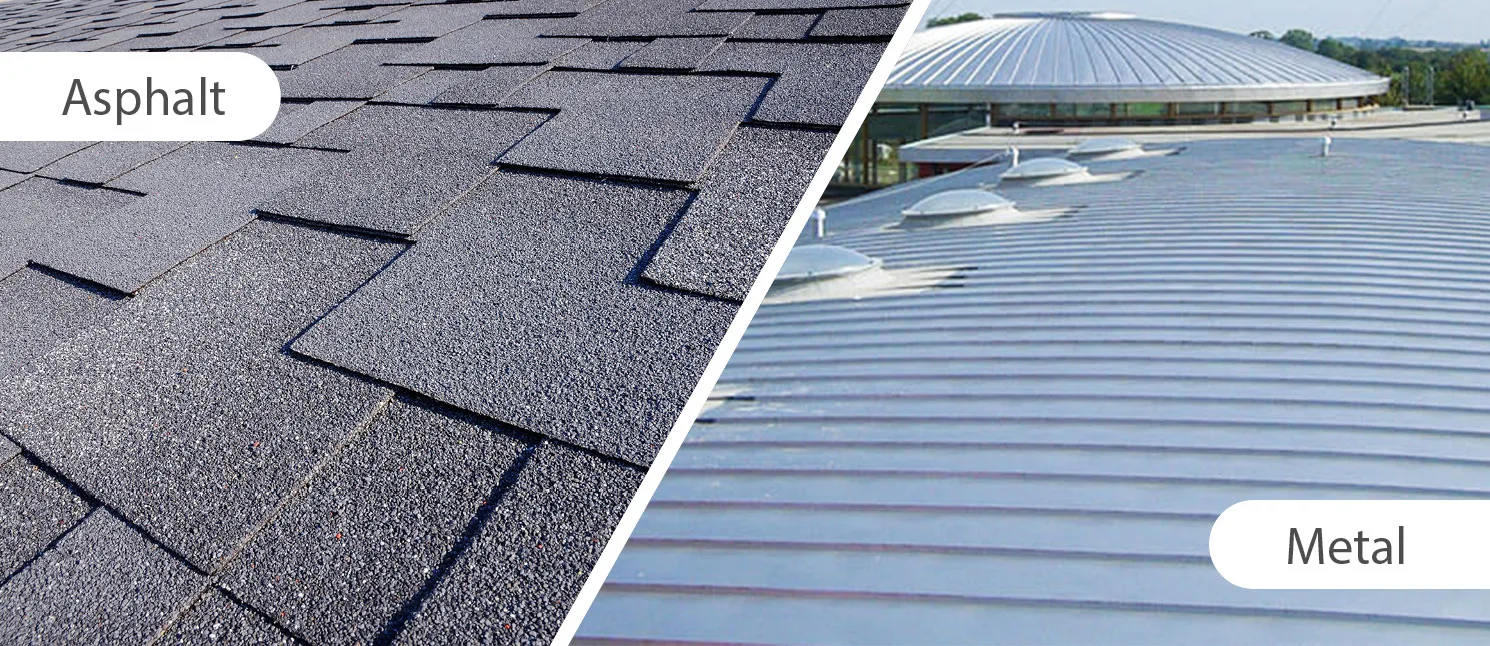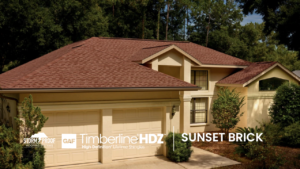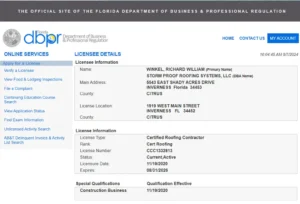Unveiling the Storm Defenders: A Comparative Odyssey between Asphalt Shingles and Metal Roofs
Introduction
In storm-prone areas, the importance of durable roofing materials cannot be overstated. These regions, characterized by their frequent encounters with hurricanes, tornadoes, and other severe weather phenomena, demand roofs that can withstand the formidable forces unleashed by nature.
A sturdy roof not only protects a home’s structural integrity but also ensures the safety and well-being of its occupants. When it comes to choosing the right roofing material for storm-prone areas, homeowners are faced with a crucial decision that will impact the resilience and longevity of their dwellings.
Brief Overview: The Importance of Durable Roofing Materials
Storms pose significant threats to buildings and their inhabitants. The high winds associated with hurricanes can exert tremendous pressure on rooftops, creating uplift forces that can lead to extensive damage if not adequately addressed.
Additionally, heavy rainfall can cause leaks and water intrusion, compromising both the structural integrity and interior environment of a home. Furthermore, in regions prone to hailstorms or intense heat from direct sunlight during summer thunderstorms, roofs must be able to withstand impact and extreme temperature differentials without succumbing to premature deterioration.
Neglecting the quality and durability of roofing materials in such areas is an invitation for disaster. Hence, it becomes imperative for homeowners in storm-prone regions to invest in high-quality roofing materials that possess exceptional resistance against nature’s fury while offering long-term protection from potential damage caused by storms.
Thesis Statement: Evaluating Performance Amidst Storms
This comparative study aims to evaluate the performance of two popular roofing materials – asphalt shingles and metal roofs – when faced with storms. By examining their respective strengths and weaknesses under various storm conditions commonly experienced in storm-prone areas, we aim to provide homeowners with valuable insights into which material may better suit their needs. Through a comprehensive analysis of key factors such as wind resistance, impact resistance, water tightness, and longevity, this study will shed light on the advantages and limitations of asphalt shingles and metal roofs.
Armed with this knowledge, homeowners will be able to make informed decisions based on their specific priorities and budget constraints. Ultimately, we believe that an informed choice between asphalt shingles and metal roofs will empower homeowners in storm-prone areas to fortify their dwellings against nature’s wrath while enjoying peace of mind during even the most tumultuous storms.
Overview of Asphalt Shingles
Definition and Composition of Asphalt Shingles
When it comes to roofing materials, asphalt shingles are the most commonly used and readily available option. These shingles consist of a base material, typically fiberglass or organic felt, coated with asphalt.
The asphalt is then mixed with mineral granules that provide protection against UV rays and enhance the aesthetic appeal. This unique composition creates a lightweight yet durable roofing solution that withstands various weather conditions.
Advantages of Asphalt Shingles
Cost-effectiveness and wide availability: One of the major advantages of asphalt shingles is their affordability compared to other roofing materials.
Whether you’re on a tight budget or looking for a cost-effective solution, asphalt shingles offer excellent value for money. Additionally, they are widely available in most regions, making them easily accessible for homeowners and contractors alike.
Variety in colors, styles, and textures to match architectural preferences: Asphalt shingles provide an array of options when it comes to customization.
With a vast range of colors, styles, and textures available in the market today, homeowners can find the perfect shingle to complement their architectural design. Be it a traditional look with classic shades or a contemporary feel with bold hues – there’s an asphalt shingle option for every taste.
Easy installation process for experienced roofers: The installation process is another aspect where asphalt shingles shine.
Experienced roofers can efficiently install these shingles due to their straightforward installation technique. The interlocking design allows for easy placement while providing stability against wind uplift.
This simplicity not only saves time during installation but also reduces labor costs associated with more complex roofing materials. Asphalt shingles’ popularity can be attributed not only to their practicality but also their versatility in meeting diverse homeowner preferences while staying within budgetary constraints.
Strengths and Weaknesses of Asphalt Shingles in Storms
Strengths: Adequate resistance against moderate winds (up to 130 mph)
When it comes to facing the fury of storms, asphalt shingles showcase commendable strength against moderate winds. With a suitable installation, these shingles can withstand wind speeds of up to 130 mph, making them a reliable choice for regions that frequently encounter gusty weather conditions.
The heavy-duty construction and interlocking design of asphalt shingles contribute significantly to their resistance against the forceful impact of wind. Furthermore, the flexibility inherent in asphalt shingles allows them to adapt and absorb some of the wind’s energy, thereby reducing the risk of damage.
This attribute is particularly beneficial in areas where storms are common but not extreme. Homeowners living in such zones can find solace knowing that their asphalt-shingled roofs offer sufficient protection during most storm events.
Good insulation properties that help regulate indoor temperature during storms
Apart from their ability to withstand moderate winds, another advantage offered by asphalt shingles lies in their insulation properties. During storms, when external temperatures might fluctuate dramatically, these shingles act as a barrier that helps regulate indoor temperatures more effectively than other roofing materials. This thermal control feature not only ensures comfort for inhabitants but also reduces energy consumption by minimizing the need for excessive heating or cooling systems.
Moreover, proper insulation provided by asphalt shingles can prevent moisture intrusion during stormy weather. By creating a watertight seal over the roof surface when correctly installed and maintained, these shingles help protect homes from water-related issues like leaks or mold growth caused by heavy rainfall or melting snow.
Weaknesses: Vulnerability to high winds and susceptibility to hail damage
Despite displaying impressive resistance against moderate winds, asphalt shingle roofs can become vulnerable when faced with more forceful gusts. Once wind speeds surpass the shingles’ rated capacity, the adhesive strips that hold them in place may weaken, leading to potential roof damage. In extreme cases, these winds can even lift or tear off individual shingles, exposing the underlying structure and leaving homes susceptible to further destruction.
Furthermore, hailstorms pose a significant threat to asphalt shingle roofs. The impact from hailstones can cause visible dents or cracks on the surface of shingles, compromising their integrity and potentially leading to leaks over time.
The severity of hail damage depends on various factors such as the size and density of hailstones, as well as the age and quality of the shingles. Homeowners residing in areas prone to frequent or severe hailstorms should carefully consider these vulnerabilities before opting for asphalt shingle roofs.
Overview of Metal Roofs
Definition and composition of metal roofs
Metal roofs have gained immense popularity due to their exceptional durability and longevity compared to other roofing materials. Typically made from steel or aluminum panels, metal roofs consist of interlocking sheets that form a protective layer over a building’s structure. Modern advancements have also led to the development of innovative metal roofing materials such as copper and zinc alloy, which offer enhanced aesthetic appeal along with durability.
Metal roofs exhibit outstanding resistance against natural elements including wind, rain, snow, and even fire. These qualities make them an ideal choice for storm-prone areas where homeowners seek long-lasting protection from harsh weather conditions.
Advantages: Exceptional durability and longevity compared to other roofing
One of the key advantages offered by metal roofs is their unparalleled durability when compared to traditional roofing materials like asphalt shingles. Metal is inherently resistant to rotting, cracking, warping, or deteriorating over time due to exposure to sunlight or moisture.
As a result, properly installed metal roofs can last significantly longer, often surpassing the typical lifespan of asphalt shingles. Moreover, metal roofs exhibit superior strength against high winds, making them an excellent choice for storm-prone regions.
Their interlocking panels and robust construction provide exceptional resistance to wind uplift and prevent the roofing material from detaching or sustaining significant damage during severe storms. To add to their benefits, metal roofs are also environmentally friendly.
They can be recycled at the end of their lifecycle, reducing waste and contributing to sustainable building practices. This eco-conscious aspect appeals to homeowners who prioritize both longevity and environmental conservation.
Conclusion
The comparative study between asphalt shingles and metal roofs for storm-resistant applications reveals distinct advantages and limitations for each roofing material. While asphalt shingles offer adequate resistance against moderate winds and provide good insulation properties during storms, they become vulnerable when exposed to high winds exceeding their rated capacity. Additionally, they are susceptible to hail damage that may compromise their integrity over time.
On the other hand, metal roofs exhibit exceptional durability and longevity compared to other roofing materials. They demonstrate remarkable strength against both high winds and hailstorms while offering long-term protection for homes in storm-prone areas.
Furthermore, metal roofs contribute positively towards sustainable building practices due to their recyclability. When considering which roofing material best suits a specific location’s needs, it is crucial to weigh these strengths and weaknesses carefully.
Ultimately, homeowners must select a roof that aligns with their priorities in terms of performance, durability, aesthetics, environmental impact, and budgetary considerations. With proper installation by experienced professionals along with regular maintenance throughout its lifespan, a well-chosen roof can weather storms with resilience while providing comfort and security for years to come.







